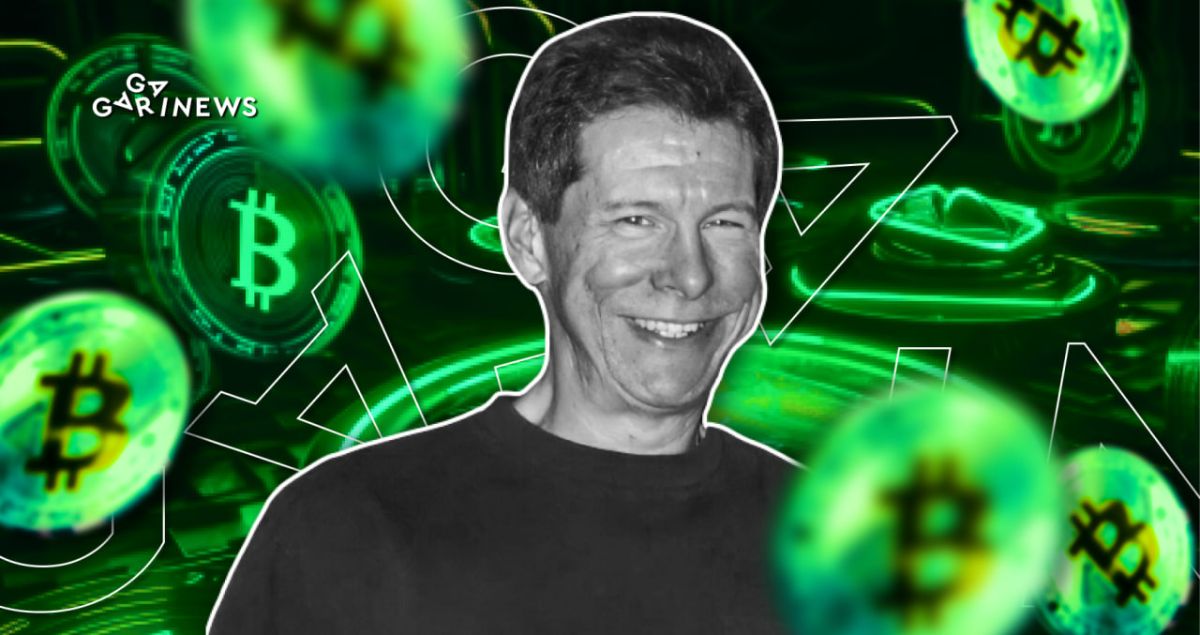Hal Finney Didn’t Believe in God, He Believed in Bitcoin’s Future

In the cryptosphere, Hal Finney is renowned as a programmer and cypherpunk who became the first documented recipient of bitcoins from Satoshi Nakamoto. Few realize that without Hal, Bitcoin might not exist at all.
On this page
GNcrypto dossier
Hal Finney
(Harold Thomas Finney II)
Claim to fame: World's first recipient of BTC and one of the pioneering Bitcoin miners.
Lifetime: 1956 – 2014. Passed away at the age of 58.
Hobbies: Extreme skiing and parkour.
Philosophical views: Libertarian, with a reverence for reason and freedom.
Unique circumstance: At 36, he willed his body to be cryonically preserved.
Bloomberg market analyst Eric Balchunas was struck upon unexpectedly reading one of Hal Finney's tweets from thirty years ago. In it, the programmer essentially outlines the concept of NFTs, which didn't begin to be experimented with until 2013.
“I’m out of my element here but based on everything I’ve seen/read Hal = Satoshi,” wrote the expert.
Hal Finney speculates about cryptographic trading cards. Source: Eric Balchunas' Twitter
Hal Finney: The nerdy libertarian
The inner conviction of Balchunas, as well as other crypto enthusiasts who associate Finney with Satoshi, may never receive convincing evidence. However, there is no doubt that Hal was one of the leaders of the community that ultimately gave birth to Bitcoin.
Hal was born in California, USA, in a large family. His father was an oilman, his mother a housewife. In the 80s, computers in American schools were a rarity, but Hal was fortunate. His school had a computer the size of a small room, operating on the Fortran language. The progressive administration used punch cards to track student attendance. Hal showed extreme interest in this process and was trusted to help teachers in such an “exciting” task. Hal truly enjoyed this — he was often seen in the school corridor with a stack of punch cards. Few were surprised when he easily gained admission into the prestigious California Institute of Technology.
Young Hal Finney Source: cryonicsarchive.org
Hal's intellectual capabilities were astonishing, even to his teachers. He often found himself at the center of lengthy philosophical discussions among students and was considered a notable personality within his institution. Friends remember Hal as someone who valued his independence above all. They share stories of him relishing in extreme, even perilous adventures, such as skiing down steep, unmarked snowy slopes, and engaging in parkour.
In university, Hal obtained a Bachelor's degree in technical sciences, as programming was not yet recognized as a separate specialty. He overlooked humanities courses, opting to pass exams as mere formality.
“He was into ideas, concepts, learning for the pleasure of it,” recalls his wife, Fran. Hal met his future wife within his first days as a student. They married immediately after graduating from university and, true to the well-known vow, only death managed to part them.
Hal and Fran's wedding Source: Fran Finney's Twitter
Hal Finney – game developer and cypherpunk
Hal started his first job at the age of 22. He joined APh Technological Consulting, a company established by his friends a few years prior. At that point, APh had already secured a contract with Mattel (a giant in today's global toy industry). Together they worked on the Intellivision, one of the first gaming consoles in the world. Hal later developed popular games of that era like Adventures of Tron (based on Disney's sci-fi movie “Tron”), Armor Ambush (a precursor to modern tank games), Astrosmash shooter, and others.
However, Hal prioritized APh's non-gaming projects such as programmable cash registers or surveillance equipment.
I never really thought of myself as primarily a games programmer. I was more of a general purpose Assembly language developer,
Finney once said.
In 1991, Hal co-authored the software program Pretty Good Privacy or PGP, aimed at developing an innovative method of encrypting electronic messages. Hal was interested in cryptography for reasons that are considered conspiratorial today – the surveillance of citizens by governments and corporations.
The work we are doing here, broadly speaking, is dedicated to this goal of making Big Brother obsolete,
Hal wrote.
It's important to note that Hal initially volunteered for PGP. At the time, the project's ideological leader, Philip R. Zimmermann, was targeted by federal investigators who believed PGP violated U.S. laws. In 1996, all charges against Zimmermann were dropped. While the investigation was ongoing, Hal was the project's behind-the-scenes leader. His discoveries and developments were privately incorporated into PGP. When the federal investigation closed, Hal was the first employee Zimmermann officially hired. Hal remained with PGP Corporation until his retirement in 2011.
During his work on PGP, Finney emerged as a prominent advocate of the cypherpunk movement. This collective was committed to fortifying online data privacy and security through the use of cryptography. Interaction among cypherpunks was primarily through an electronic mailing list, forming the incubator for the idea of digital currencies. A multitude of exploratory ventures took place, with Finney himself creating a method for reusable proofs of work, albeit non-functional. In 2008, when Satoshi Nakamoto unveiled Bitcoin, Finney was among a select few from the mailing list who threw their full support behind Nakamoto's innovation. Intriguingly, Bitcoin incorporates some cryptographic elements previously integrated into PGP by Finney himself.
Cryptographers have seen too many grand schemes by clueless noobs… I was more idealistic; I have always loved crypto, the mystery and the paradox of it,
Finney recollected.
Immediately upon its release, Finney installed the “Bitcoin” software onto his IBM desktop. Among cypherpunk circles, he is regarded as likely the second individual worldwide to commence BTC mining, right after Satoshi. Subsequently, Nakamoto dispatched 10 BTC to his virtual comrade, constituting the first transaction in the Bitcoin network. They engaged in vibrant discussions about detected glitches, collaboratively troubleshooting the issues. Finney was completely unaware of Satoshi's physical appearance or location, envisaging him as a savvy, young Japanese individual.
Historic tweet from Finney about initializing a Bitcoin node. Source: Developer's Twitter.
The pioneer miner and cryonics enthusiast
Finney's foray into BTC mining lasted several weeks before he chose to discontinue. His antiquated computer was prone to overheating and potential malfunction. According to his wife, the family perceived mining as an amicable gesture of support for Satoshi's endeavor. In her words, while others found faith in God, her husband placed his trust in Bitcoin's future. Initially, the BTC was safeguarded on a hard drive, later to be relocated onto a DVD by Finney.
Around the same time, Hal's health started deteriorating. He received the grim diagnosis of Amyotrophic Lateral Sclerosis (ALS).
“I hope to be able to read, browse the net, and even participate in conversations by email and messaging… I may even still be able to write code, and my dream is to contribute to open source software projects even from within an immobile body. That will be a life very much worth living,” Finney wrote on his blog.
Despite the relentless progression of his illness, Finney was already pondering how to diminish the ecological footprint of mining as early as 14 years ago. Source: Hal's Twitter
Interestingly, Hal Finney showed a profound interest in cryonics, a full 17 years before his debilitating diagnosis. Cryonics involves preserving human bodies in a deep freeze, in anticipation of future medical breakthroughs that may facilitate their revival and healing. Back in 1992, Hal and his wife Fran entered into an agreement with the Alcor Life Extension Foundation. This non-profit organization has been performing cryonics-related experiments for over fifty years. Per the agreement, upon their passing, their bodies are to be conserved in liquid nitrogen at a chilly -196 degrees Celsius.
In my personal opinion, anyone born today has a better than 50-50 chance of living effectively forever,
declared Finney.
Over the past few years, Hal's facial muscles have become the true champions of mobility, allowing him to work and engage with visitors, thanks to his expressive mimics and the unwavering support of his loving wife. Not only that, but Finn took on the noble task of enhancing the Bitcoin protocol, utilizing a video camera and cutting-edge software that kept a keen eye on his every glance.
The family partially covered Hal's medical treatment and care costs through the Bitcoins he had mined during his early collaborations with Satoshi.
I’m pretty lucky overall. Even with the ALS, my life is very satisfying. But my life expectancy is limited. I’m comfortable with my legacy,
Hal Finney wrote a year before his passing.
During the final years, Hal courageously fought his severe ailment. Source: Forbes
The content on The Coinomist is for informational purposes only and should not be interpreted as financial advice. While we strive to provide accurate and up-to-date information, we do not guarantee the accuracy, completeness, or reliability of any content. Neither we accept liability for any errors or omissions in the information provided or for any financial losses incurred as a result of relying on this information. Actions based on this content are at your own risk. Always do your own research and consult a professional. See our Terms, Privacy Policy, and Disclaimers for more details.































